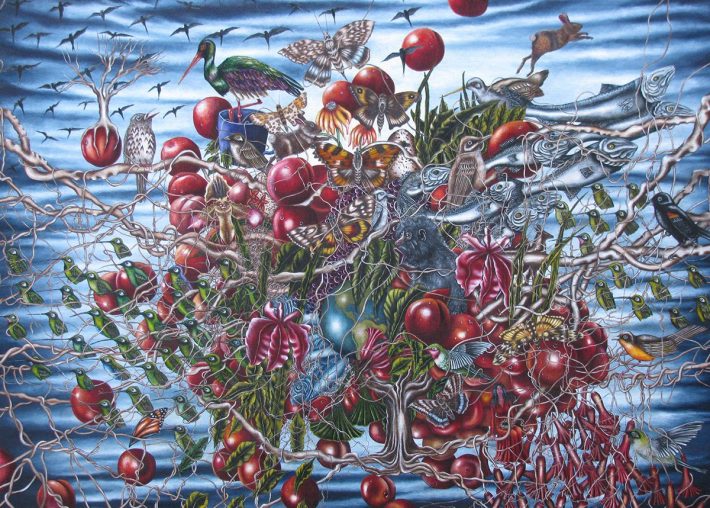Jacqueline Bishop’s work conveys the creeping dread she feels as the landscapes upon which we depend yield to human pressure.
By James Fox-Smith via countryroadsmagazine.com
Sponsored by Tangipahoa Parish Tourism

“World View,” 2010, Oil on Belgian linen, 34″ x 42″,by Jacqueline Bishop
Dozens of pairs of scavenged baby shoes line the shelves in Jacqueline Bishop’s New Orleans studio. Collected by the artist from the streets of cities in America and of third-world countries, each pair of shoes serves as a tiny canvas, upon which the artist has painted exquisite portraits of flora and fauna—orchids, honeyeaters—that have vanished from their native range as the tide of human civilization rolls on. Part of a body of work named “Losing Ground: Imaginary Landscapes,” made in 2004 and 2005, the shoes express Bishop’s conviction that the natural landscapes that sustain us are receding beyond our children’s grasp, because of the decisions that adults have made about how to treat them.
Changing landscapes, loss of biodiversity, deforestation; and the connection of these issues with uniquely human problems like poverty, crime, and social unrest—in Bishop’s work, these themes surface again and again as the artist strives to convey the creeping dread she feels as the landscapes upon which we depend yield to human pressure. Whether rendered on canvas, in paper collage, or by utilizing more unexpected surfaces such as children’s dresses or the aforementioned shoes, her depictions of endangered flora and fauna are at once attentively realistic and deeply surreal, capturing the intricate beauty of natural forms; and the complex connections between climate change, species extinction, and migration. Rich with allegorical symbolism, many mixed-media assemblages incorporate birds’ nests, toys, cast-off shoes, and other items both natural and man-made—that Bishop collects from the environments through which she moves. In a process she describes as “using the landscape to address landscape issues,” she collects newsprint and discarded paper during travels to third-world countries, using it to create a collage, which she then paints on using watercolor mixed with waters from the Amazon, the Mississippi, or the post-BP oil spill Gulf of Mexico. The blend of materials and chemicals produces unpredictable results—a striking corollary given the choice of subject matter. These are landscapes designed to confront, presenting a fractured paradise in the process of adapting to, or disappearing beneath, the tide of material things. Describing Bishop’s work in his book Expressions of Place: The Contemporary Louisiana Landscape, John R. Kemp wrote, “Her surreal images of the landscape evoke thoughts about death and rebirth, tranquility and destruction, light and dark, and humanity’s lost intimacy with nature.”
Contemporary art dealer Arthur Roger, who has represented Bishop for close to thirty years, said, “The most remarkable aspect of Jackie’s work to me is that she generally works in isolation, but seems to see more clearly the pulse of the outside world … She has an innate connection to the world, and her audience truly appreciates her vision, far after she does her paintings.”Indeed, standing before them, the viewer is not only struck by the beauty of nature’s creations but forced to consider too the political and social forces that threaten them. Where will our children’s shoes—and their imaginations—take them, she seems to ask, if there’s nothing unspoiled left for them to see?
For more than thirty years Jacqueline Bishop has been represented by Arthur Roger Gallery in New Orleans. This fall she will collaborate with Chef Phillip Lopez of Root NOLA, to create a series of dishes inspired by her work. Their collaboration will be profiled in a series of segments that will run on LPB’s Art Rocks, hosted by Country Roads publisher James Fox-Smith, in September and October, culminating in a dinner at LPB’s studios on Sunday, October 22. Stay tuned for details.
